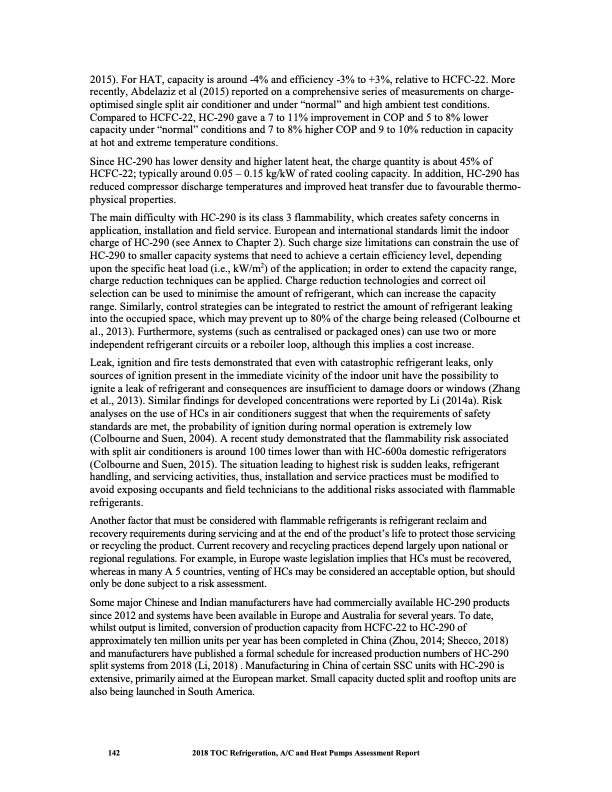
PDF Publication Title:
Text from PDF Page: 155
2015). For HAT, capacity is around -4% and efficiency -3% to +3%, relative to HCFC-22. More recently, Abdelaziz et al (2015) reported on a comprehensive series of measurements on charge- optimised single split air conditioner and under “normal” and high ambient test conditions. Compared to HCFC-22, HC-290 gave a 7 to 11% improvement in COP and 5 to 8% lower capacity under “normal” conditions and 7 to 8% higher COP and 9 to 10% reduction in capacity at hot and extreme temperature conditions. Since HC-290 has lower density and higher latent heat, the charge quantity is about 45% of HCFC-22; typically around 0.05 – 0.15 kg/kW of rated cooling capacity. In addition, HC-290 has reduced compressor discharge temperatures and improved heat transfer due to favourable thermo- physical properties. The main difficulty with HC-290 is its class 3 flammability, which creates safety concerns in application, installation and field service. European and international standards limit the indoor charge of HC-290 (see Annex to Chapter 2). Such charge size limitations can constrain the use of HC-290 to smaller capacity systems that need to achieve a certain efficiency level, depending upon the specific heat load (i.e., kW/m2) of the application; in order to extend the capacity range, charge reduction techniques can be applied. Charge reduction technologies and correct oil selection can be used to minimise the amount of refrigerant, which can increase the capacity range. Similarly, control strategies can be integrated to restrict the amount of refrigerant leaking into the occupied space, which may prevent up to 80% of the charge being released (Colbourne et al., 2013). Furthermore, systems (such as centralised or packaged ones) can use two or more independent refrigerant circuits or a reboiler loop, although this implies a cost increase. Leak, ignition and fire tests demonstrated that even with catastrophic refrigerant leaks, only sources of ignition present in the immediate vicinity of the indoor unit have the possibility to ignite a leak of refrigerant and consequences are insufficient to damage doors or windows (Zhang et al., 2013). Similar findings for developed concentrations were reported by Li (2014a). Risk analyses on the use of HCs in air conditioners suggest that when the requirements of safety standards are met, the probability of ignition during normal operation is extremely low (Colbourne and Suen, 2004). A recent study demonstrated that the flammability risk associated with split air conditioners is around 100 times lower than with HC-600a domestic refrigerators (Colbourne and Suen, 2015). The situation leading to highest risk is sudden leaks, refrigerant handling, and servicing activities, thus, installation and service practices must be modified to avoid exposing occupants and field technicians to the additional risks associated with flammable refrigerants. Another factor that must be considered with flammable refrigerants is refrigerant reclaim and recovery requirements during servicing and at the end of the product’s life to protect those servicing or recycling the product. Current recovery and recycling practices depend largely upon national or regional regulations. For example, in Europe waste legislation implies that HCs must be recovered, whereas in many A 5 countries, venting of HCs may be considered an acceptable option, but should only be done subject to a risk assessment. Some major Chinese and Indian manufacturers have had commercially available HC-290 products since 2012 and systems have been available in Europe and Australia for several years. To date, whilst output is limited, conversion of production capacity from HCFC-22 to HC-290 of approximately ten million units per year has been completed in China (Zhou, 2014; Shecco, 2018) and manufacturers have published a formal schedule for increased production numbers of HC-290 split systems from 2018 (Li, 2018) . Manufacturing in China of certain SSC units with HC-290 is extensive, primarily aimed at the European market. Small capacity ducted split and rooftop units are also being launched in South America. 142 2018 TOC Refrigeration, A/C and Heat Pumps Assessment ReportPDF Image | Heat Pumps Technical Options

PDF Search Title:
Heat Pumps Technical OptionsOriginal File Name Searched:
RTOC-assessment-report-2018_0.pdfDIY PDF Search: Google It | Yahoo | Bing
CO2 Organic Rankine Cycle Experimenter Platform The supercritical CO2 phase change system is both a heat pump and organic rankine cycle which can be used for those purposes and as a supercritical extractor for advanced subcritical and supercritical extraction technology. Uses include producing nanoparticles, precious metal CO2 extraction, lithium battery recycling, and other applications... More Info
Heat Pumps CO2 ORC Heat Pump System Platform More Info
| CONTACT TEL: 608-238-6001 Email: greg@infinityturbine.com | RSS | AMP |